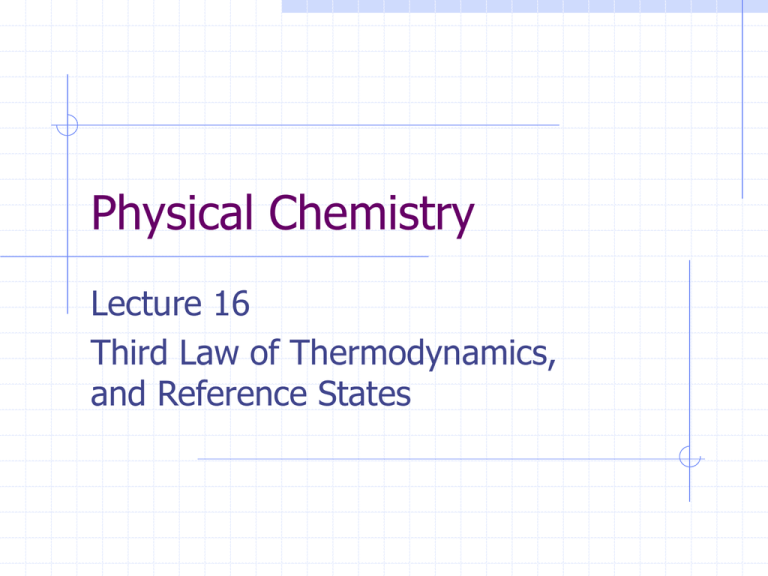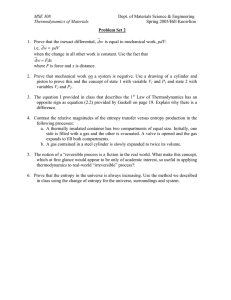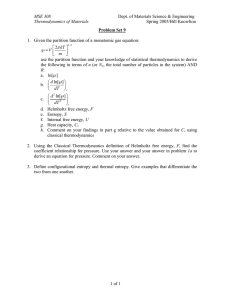Physical Chemistry Lecture 16 Third Law of Thermodynamics, and Reference States
advertisement

Physical Chemistry Lecture 16 Third Law of Thermodynamics, and Reference States Reference state Must tie the absolute values of state functions to some reference point One must define the constant, Sθ(0), in an equation like θ ′ C θ θ P (T ) S (T ) = S (0) + ∫ dT ′ T′ 0 T Then the entropy at all other temperatures is found through this equation Third law of thermodynamics Define the entropy at a specific set of conditions, namely T = 0 K The entropy of all pure, crystalline substances is the same at the absolute zero of temperature. That entropy is assigned the value of zero. Does not say that the entropy of every substance is zero at these conditions. Heat capacity measurements Determine the heat capacity from 0 K to temperature of interest to be able to evaluate entropy Examples of heat capacity measurements Debye theory of heat capacity of crystalline solids Must know the heat capacity at all temperatures to define entropy Difficult to measure for T near 0K Use a theoretical evaluation of lowtemperature heat capacity by Peter J. W. Debye θ C P (T ) = AT 3 Debye considered the solid a group of vibrating atoms in a lattice Debye model for heat capacity Lattice vibrations of a solid Transverse Longitudinal Each absorbs energy from an external source Sum over all possible lattice vibrations to obtain the manner in which energy is taken up Origin of heat capacity of solid materials Methodology for using Debye theory to obtain standard entropy Evaluate integral in parts S θ (T ) = S θ (0) + T* θ C P (T ) ∫0 T dT C Pθ (T ) + ∫ dT T T* T Evaluation using Debye theory S θ (T ) = S θ (0) + θ * C P (T ) 3 C Pθ (T ) + ∫ dT T T* T The remaining integral is carried out numerically Standard third-law entropies of selected elements at 298.15 K Element Sθ (J/K-mole) Element Sθ (J/K-mole) Aluminum 28.33 Nitrogen 191.61 Barium 62.80 Oxygen 205.13 Carbon (gr) 5.74 Silver 42.55 Chlorine 223.07 Sodium 51.21 Hydrogen 130.68 Sulfur (rh) 31.80 51.55 Iron 27.28 Tin Mercury 76.02 Xenon 169.68 Reference state for real gases The standard state for any gas is the equivalent ideal gas at 1 bar This results in a “tricky” evaluation of entropy of the real gas The evaluation from the reference state requires one to integrate through a point which the real and ideal gas have in common Reference state for real gases The entropy of a real gas is a sum of terms S (T , P) = S θ (T ) + ∆S = S θ (T ) + ∆Sideal + ∆S real Reference state for real gases The entropy of a real gas is a sum of terms ∂V ∂V S (T , P) = S m (T ) − ∫ m dP − ∫ m dP ∂T P ,ideal ∂T P ,real 0 Pθ θ 0 P ∂V ∂V ∂V dP + ∫ m dP − ∫ dP = S m (T ) − ∫ m ∂T P ,ideal ∂T P ,ideal ∂T P ,real 0 0 Pθ θ P P ∂V dP + = S m (T ) − ∫ m ∂T P ,ideal Pθ θ P P R ∂V dP − ∫0 P ∫0 ∂T P,real dP P R ∂V dP = Sideal (T , P) + ∫ − P ∂T P ,real 0 P P Summary Reference values of state functions specified Third law of thermodynamics defines the entropy at a specific state Pure crystalline material 0K Values at other states found by integration Debye’s theory determines change at low T Reference state of gases is ideal gas at 1 bar Integration through P = 0 “Correction” terms for nonideality








